The Skyscraper Museum is devoted to the study of high-rise building, past, present, and future. The Museum explores tall buildings as objects of design, products of technology, sites of construction, investments in real estate, and places of work and residence. This site will look better in a browser that supports web standards, but it is accessible to any browser or Internet device.
CHINA PROPHECY: SHANGHAI
June 24, 2009 through April 11, 2010
CLICK HERE for a Virtual Walkthrough and a tour of the exhibition with director Carol Willis on BatteryPark.tv
CHINA PROPHECY IN THE PRESS: Wall Street Journal; Architect's Newspaper; eOculus.
[DOWNLOAD Exhibition Press Release]
CLICK HERE for full video coverage of our related lecture series, Shanghai Skyline
China Prophecy: Shanghai explores 21st-century skyscraper city of Shanghai
and is the third in a cycle of three related exhibitions entitled FUTURE CITY: 20 | 21 that
juxtaposes a retrospective of American visions of the skyscraper city of the future from the
early 20th century with an exploration of Chinese cities today, pursuing the parallel conditions
of rapid modernization and urbanization. The second exhibition of the cycle,
Vertical Cities focused on Hong Kong and New York.
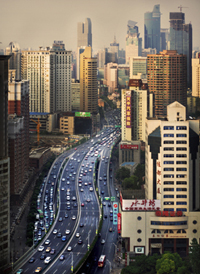
"Urban Street"
Staffan Holgersson
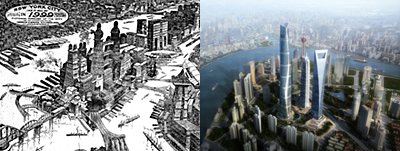
Left: "New York 1999," New York World, December 30, 1900
Right: Lujiazui trio, Gensler

Hong Kong Midlevels, P&T Architects
The second exhibition in the three part series, FUTURE CITY: 20|21, Vertical Cities examined the parallels during two major development booms and defining moments in the vertical identity of New York in the 1920s and 1960s and Hong Kong in the mid-1980s-1990s and today. Today, as high-rises proliferate everywhere, Hong Kong holds the title with 7,200. Still ascending, though, Shanghai is surely China's prophecy of the urban future.
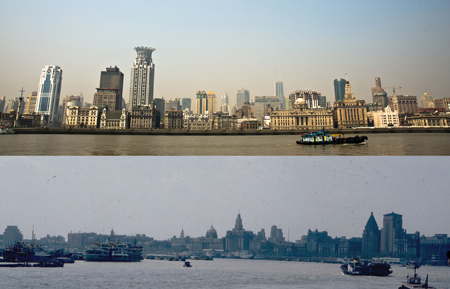
Change Along the Bund Since 1980
Top: Jakob Montrasio, Bottom: Katte Belletje
China Prophecy documents this stupendous urban transformation through film and photographs of old and new Shanghai, including a 20-minute video odyssey traveling the city's streets and highways filmed by resident photographer Jakob Montrasio. Evoking the speed and ambition of the city's futuristic focus are projected computer animations by the Chinese company Crystal CG that create spectacular flyovers of the city before circling the major skyscrapers that are their subjects.

From left: Lujiazui from Puxi (rendering), Gensler; Lujiazui, Gensler; Magnolia Plaza rendering, SOM
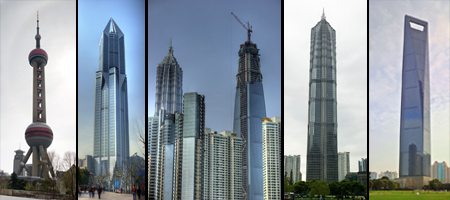
From left: Oriental Pearl TV Tower; Tomorrow Square; Jin Mao and SWFC (under construction); Jin Mao; SWFC, all (c) Jakob Montrasio
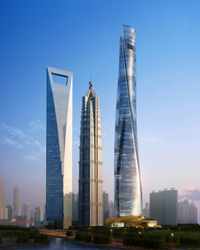
Shanghai Tower, Gensler
These new Shanghai super-skyscrapers are ambitious in their height and innovative engineering. At 1380 ft. (438 meters), Jin Mao, designed by the Chicago office of Skidmore Owings & Merrill, is taller than the Empire State Building; the Shanghai World Financial Center, designed by New York-based architects KPF, is taller than any U.S. skyscraper at 1614 ft (492 meters); and Shanghai Tower, designed by the American firm Gensler, has an announced height of 2073 ft (632 meters), which will make it the tallest building in China and the second tallest in the world. Typical of these Shanghai towers, as well as those being built today throughout Asia and the Mideast, is a mixed-use program that includes a commercial base, zones of offices, residences or luxury hotels, and restaurants and observation desks on the top floors. The concept of the structure as a "vertical city" is often invoked-offering parallels to early twentieth-century visions of New York as the city of the future.
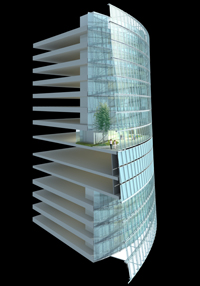
Sky Lobby of Shanghai Tower, Gensler
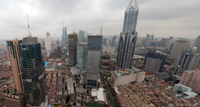
Nanjing Road Panorama, Jakob Montrasio
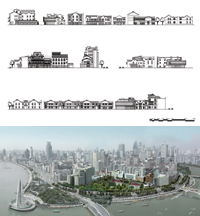
Top: Xintiandi Elevations (new), Studio Shanghai; Bottom: Rockbund Redevelopment Aerial Rendering, The Rockefeller Group
CLICK HERE for a Google Map of all highrise buildings in Shanghai above 150 meters that are either proposed, approved, or under construction.
CLICK HERE for a map of major Lujiazui Skyscrapers!
* * *
"China Prophecy: Shanghai" is supported, in part, by public funds from the New York City Department of Cultural Affairs.
"China Prophecy: Shanghai" is supported, in part, by public funds from the New York State Council on the Arts, a State Agency.


